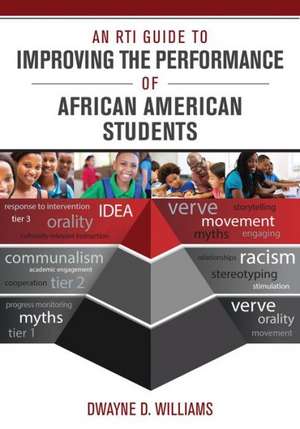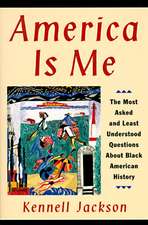An RTI Guide to Improving the Performance of African American Students
Autor Dwayne D. Williamsen Limba Engleză Paperback – 7 iul 2015
Research shows that students of color learn best in classrooms that reflect their cultural values. This breakthrough book shows educators how to create culturally relevant RTI models that help diverse students thrive!
Step-by-step, you’ll learn to skillfully apply 4 core characteristics critical to culturally responsive instruction: communalism, movement expressiveness, orality, and verve. Richly detailed case studies and evidence-based, process-focused strategies will help you to:
- Understand how and why culture mediates learning
- Dispel cultural biases and appreciate the assets among all student groups
- Address all tiers of the RTI model across grade levels
- Eliminate disproportionality in special education eligibility decisions
- Work collaboratively with African American parents and communities
Preț: 230.58 lei
Nou
Puncte Express: 346
Preț estimativ în valută:
44.13€ • 45.90$ • 36.43£
44.13€ • 45.90$ • 36.43£
Carte tipărită la comandă
Livrare economică 12-26 aprilie
Preluare comenzi: 021 569.72.76
Specificații
ISBN-13: 9781483319735
ISBN-10: 1483319733
Pagini: 280
Dimensiuni: 178 x 254 x 22 mm
Greutate: 0.59 kg
Ediția:1
Editura: SAGE Publications
Colecția Corwin
Locul publicării:Thousand Oaks, United States
ISBN-10: 1483319733
Pagini: 280
Dimensiuni: 178 x 254 x 22 mm
Greutate: 0.59 kg
Ediția:1
Editura: SAGE Publications
Colecția Corwin
Locul publicării:Thousand Oaks, United States
Recenzii
"All educators working with diverse students should read this book! Using personal experiences, the author provides examples of culturally responsive classroom instruction that brings tears to my eyes realizing what I missed in my own education."
"Diversity in race and culture is one of the greatest issues facing students and teachers in education today. Without changing our mindset and understanding how others learn, we will never meet the expectations of educating all people. This book is outstanding in addressing these issues. It is truly a powerful read and something all educators should keep as a resource when making decisions for students who do not fall into that stereotypical 'box'."
"This book presents salient and provocative ideas with regards to teaching the way students learn. These ideas are not readily spoken about in teacher preparation programs or in schools. This book provides an avenue to discuss the ways African American students learn best."
"Diversity in race and culture is one of the greatest issues facing students and teachers in education today. Without changing our mindset and understanding how others learn, we will never meet the expectations of educating all people. This book is outstanding in addressing these issues. It is truly a powerful read and something all educators should keep as a resource when making decisions for students who do not fall into that stereotypical 'box'."
"This book presents salient and provocative ideas with regards to teaching the way students learn. These ideas are not readily spoken about in teacher preparation programs or in schools. This book provides an avenue to discuss the ways African American students learn best."
Cuprins
A Note to the Reader
Acknowledgments
Introduction
About the Author
Part 1: Culturally Relevant Response to Intervention (CR-RTI)
1. How Did We Get Here?
2. Response to Intervention
3. Culturally Relevant Response-to-Intervention (CR-RTI) Models
4. Theory and Culturally Relevant Models
5. Scientific Research-Based Instruction and CR-RTI
6. Step-by-Step Approach to Creating CR-RTI Models
7. Cultural Characteristics and Academic Engagement
8. Cultural Characteristics in the Classroom
Part 2: Vignettes
9. "Entertainment?! Why Can’t Our Children Just Sit Down and Learn?"
10. What Does Academic Engagement Look Like for Many Children of Color?
11. Motivation: The Key to Success
12. Respecting Children and Their Cultural Backgrounds
13. Racism: Does it Exist in Today’s School System?
14. Getting Parents to Buy Into Your RTI Model
15. Using Community Resources: A School-Church RTI Approach
Part 3: Application
16. Peer-Mediated Learning: An Emphasis on Communalism
17. Culturally Relevant Reading and Writing Instruction
18. Communalism and Instruction at the Tier 1 Level
19. Movement and Instruction at the Tier 1 Level
20. Orality and Tier 1 Instruction
21. Verve, Evaluation Systems, and Instruction
22. Tying It All Together Within an RTI Framwork
23. RTI for Students of Color at the High School Level
Reflections
References
Index
Acknowledgments
Introduction
About the Author
Part 1: Culturally Relevant Response to Intervention (CR-RTI)
1. How Did We Get Here?
2. Response to Intervention
3. Culturally Relevant Response-to-Intervention (CR-RTI) Models
4. Theory and Culturally Relevant Models
5. Scientific Research-Based Instruction and CR-RTI
6. Step-by-Step Approach to Creating CR-RTI Models
7. Cultural Characteristics and Academic Engagement
8. Cultural Characteristics in the Classroom
Part 2: Vignettes
9. "Entertainment?! Why Can’t Our Children Just Sit Down and Learn?"
10. What Does Academic Engagement Look Like for Many Children of Color?
11. Motivation: The Key to Success
12. Respecting Children and Their Cultural Backgrounds
13. Racism: Does it Exist in Today’s School System?
14. Getting Parents to Buy Into Your RTI Model
15. Using Community Resources: A School-Church RTI Approach
Part 3: Application
16. Peer-Mediated Learning: An Emphasis on Communalism
17. Culturally Relevant Reading and Writing Instruction
18. Communalism and Instruction at the Tier 1 Level
19. Movement and Instruction at the Tier 1 Level
20. Orality and Tier 1 Instruction
21. Verve, Evaluation Systems, and Instruction
22. Tying It All Together Within an RTI Framwork
23. RTI for Students of Color at the High School Level
Reflections
References
Index
Notă biografică
Descriere
Guides educators toward an understanding of the socio-cultural characteristics of classrooms and why such an understanding is critical to fostering academic engagement of African American students.













